The Catalan giants have waited 87 years for this single moment. For 87 long years, Real Madrid were seen as the better of the two eternal rivals, having a lead in head-to-head Clasico clashes. But this Saturday, Barcelona finally did it – they have finally turned the tides and made history. As it now stands in all-time meetings between the Blaugrana and the Royal Whites, Barcelona have 96 wins while Real Madrid are on 95: a truly historic comeback for the Catalans.
But as if this was already not enough, Barcelona have managed to completely bury their rivals in the span of three meagre days. First, they eliminated them from Copa del Rey with a brutal 3-0 showing. Then, two days after that, they crushed their La Liga hopes by expanding their lead to a mighty 12 points, leaving Real Madrid with little to hope for.
This tactical analysis will use statistics to determine just how Barcelona managed another win against Real Madrid at the Santiago Bernabeu, their 11th from the last 18 matches in the hearth of the Spanish capital.
Lineups
Barcelona (4-4-2)
Starting XI: Ter Stegen – Sergi, Pique, Lenglet, Alba – Rakitic, Busquets, Arthur – Messi, Suarez, Dembele
Bench: Cillessen, Semedo, Umtiti, Vidal, Aleñá, Coutinho, Malcom
Coach: Ernesto Valverde
Real Madrid (4-3-3)
Starting XI: Courtois – Carvajal, Varane, Ramos, Reguilon – Modric, Casemiro, Kroos – Bale, Benzema, Vinicius
Bench: Navas, Marcelo, Valverde, Lucas, Asensio, Isco, Ceballos
Coach: Santiago Solari
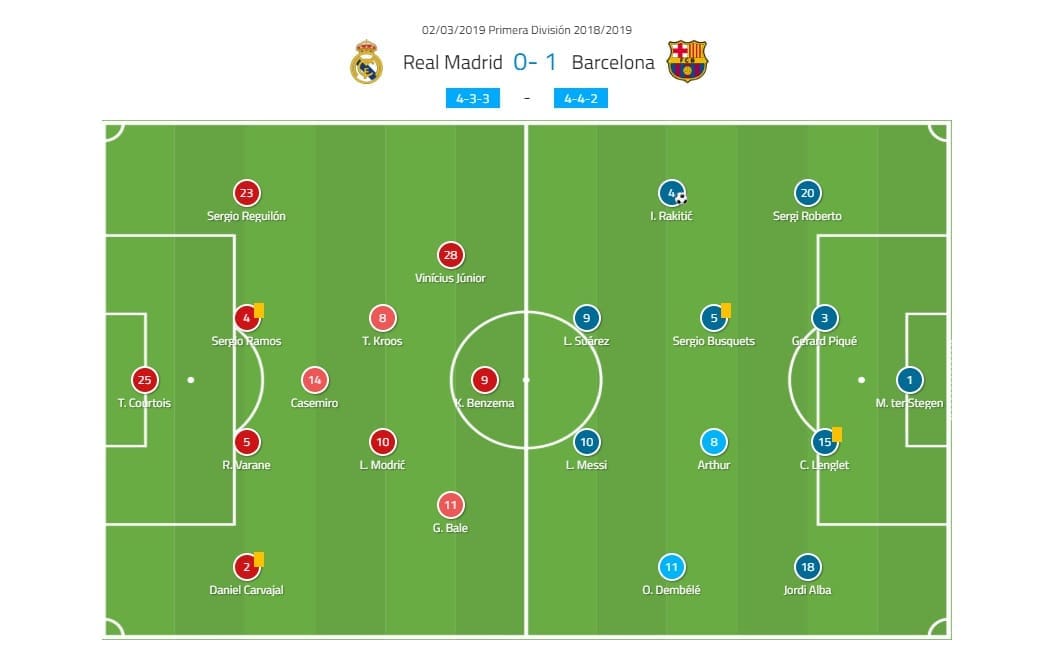

Barcelona setup
Seeing how he beat Real Madrid 3-0 just a couple of days ago in the Cup, many would think that Ernesto Valverde wouldn’t have to tinker with his lineup too much. As the Ant himself admitted after the game however, the team might have won but the performance was still lacking. For that reason, he made a couple of tactical changes.
As far as personnel went, Barcelona made only two changes to the team that came out victorious at the Bernabeu in Copa del Rey. The biggest, and what turned out to be the most important news, was the return of Arthur Melo who assumed his position at the left side of the midfield trident next to Sergio Busquets and Ivan Rakitić.
The second change was Sergi Roberto for Nelson Semedo, who showed heart but left the Bernabeu with a bittersweet performance last time and was thus replaced in favour of the Spaniard. The rest of the team was unchanged and operated in a 4-4-2 system throughout the game.
Real Madrid setup
Just like his rival, Santiago Solari made two changes to the team in hopes of a much better result. Lucas Vazquez was discarded and in his place came the speedy Welshman Gareth Bale. Los Blancos also decided to field Thiabut Courtois between the sticks instead of Keylor Navas, who had a pretty impressive night a couple of days ago.
Real were somewhat the better team in the second leg of the Copa, so Solari’s decision not to bring in too many changes was understandable and also predictable. Still, that might have cost him in the long run because Valverde knew exactly what to prepare for.
The Royal Whites operated in a 4-3-3 scheme that remained mostly the same for the whole 90 minutes of the match, only going through minor changes in transitions and the exchange of personnel.
Barcelona show signs of adaptation
Even though their victory in the Cup was much more impressive as far as the scoreline goes, Barcelona should be more proud of their La Liga triumph as it came off of a great performance as a whole. Ernesto Valverde played reactive football a couple of days prior to this clash but this time, he chose to control proceedings and not wait for Real Madrid’s mistakes.
The biggest flaw in his last lineup was the evident misuse of his right wing. In an attempt to stop Vinicius Junior from wreaking havoc down Madrid’s left flank, he decided to deploy the combination of Sergi Roberto and Nelson Semedo, an already seen tandem that is a solid defensive outlet but offers little going the other way around. This plan mostly failed as the duo were outnumbered and bested on numerous occasions as well as Barcelona completely sacrificing one of their wings for that strategy to work.
This time, however, with Arthur Melo returning to the lineup, Valverde decided to employ a tried and tested scheme that works both ways. And who was at the core of that plan? Why, Ivan Rakitić, of course.
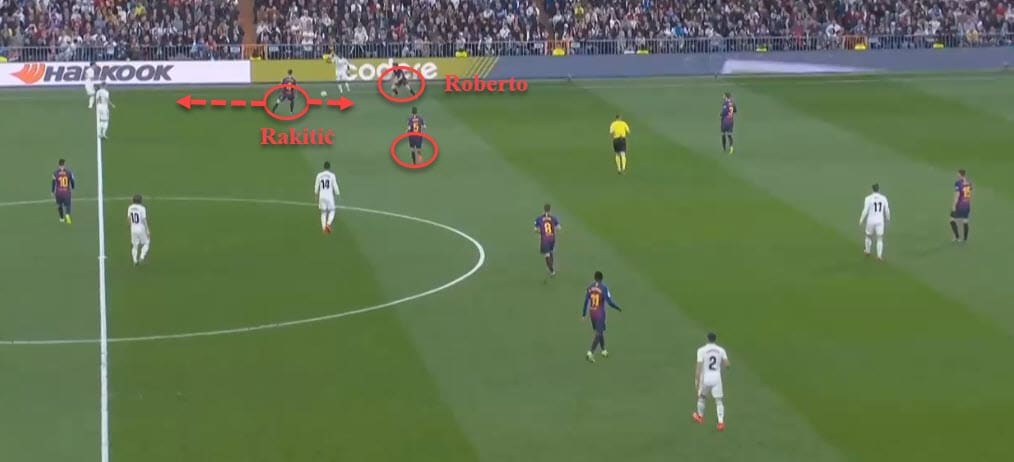
Notice how the overlap of Sergio Reguilon is stopped by Rakitić as the Croat assumes a defensive position on the right as soon as the Madrid duo try to combine. Sergi Roberto was still tasked with dealing with Vinicius Junior mostly on his own but Barcelona were not outnumbered anymore as they had been before.
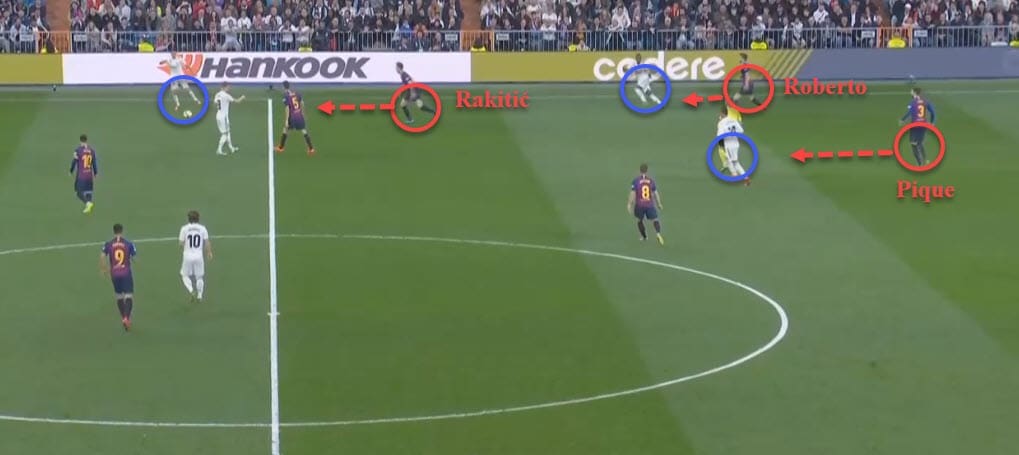
Sergio Busquets was also almost always a part of that pressing squad that would keep Real Madrid’s left side in check. The Octopus of Badia would push with Rakitić higher up the pitch, forcing the Whites to fall back or lose the ball.
One other thing worth noticing is the positioning of Pique. Last time we concluded how Benzema would usually drop deeper to create numerical superiority and Pique couldn’t follow him because that would open space for Vinicius to run in behind the defence. This time, with Real’s every option covered, Pique could set up his line much higher, and completely nullify the attempt of overcrowding by the hosts.
So that was the first part of the equation dealt with for Valverde since he managed to diminish Real’s only threat going forward, which was that left side of the pitch. The combination of Rakitić and Busquets as the support to a highly motivated Roberto managed to stop the bleeding and keep Barcelona out of harm’s way.
But the other part was the attacking outlet that the Catalans lacked in the last match. Funnily enough, the decision to move Rakitić higher up the pitch and unleash him solved the attacking aspect, as well.
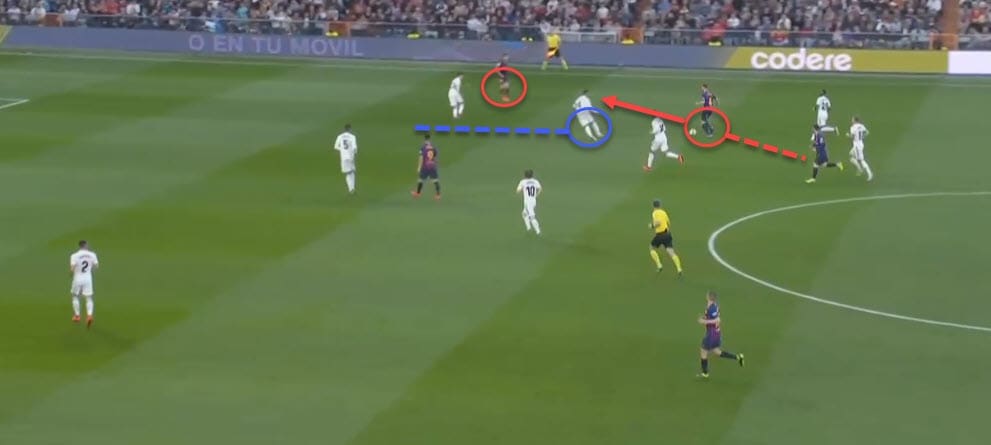
It is not uncommon to see the Croat in the final third or even on the wings as he actually started his career as a winger who slowly transitioned to a number 10 or a deeper number six role as more time passed. At Barcelona he is a bit of everything, and mostly accommodates his position to the teams’ needs.
Now, the team and his coach needed him to be their attacking threat down the right, and he was exactly that with his dribbles and darting runs, which, unsurprisingly, yielded the Catalans the only goal of the evening.
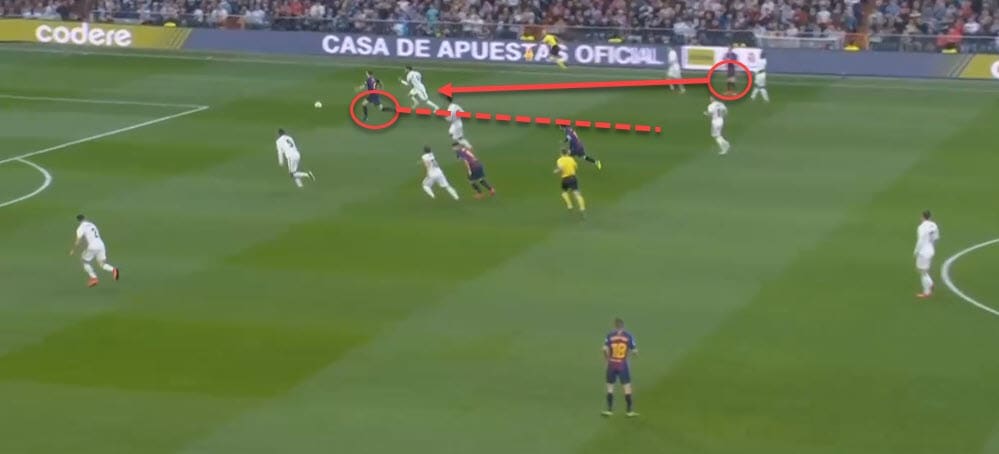
After having pulled Sergio Ramos out of his position and making him break the defensive line with his progressive run into the final third, Rakitić quickly sends the ball to Roberto for a sly one-two to beat the whole defence.
The end-product? The winning goal.
Setting the tempo
It is really interesting to see how only one player can change the game so much. Of course, usually we would be talking about Lionel Messi right about now but it’s actually Arthur Melo who has brought more control and stability to this Barcelona side.
What they lacked in the Copa match, they gained in this La Liga one as the young Brazilian once again dictated the tempo, and allowed the others to play more freely. His ability to progress the ball from deep positions and to move it up in the face of pressure, even when outnumbered, made the world of difference for the away side.
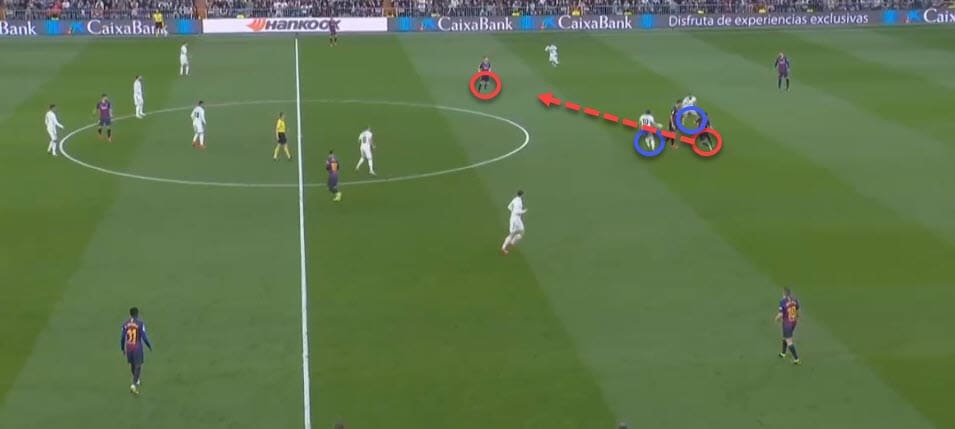
Notice how Arthur uses Busquets as a shield to mask his pass to Rakitić, getting rid of the pressing duo and moving the ball higher up the pitch. Another example of him creating space for his teammates was visible in his movement.
Real would press in a familiar shape, trying to collapse on the ball carriers and block their passing lanes, but the tandem of Busquets and Arthur was more than enough to wiggle through and supply the ball forward. In the example below the Brazilian lures Benzema in, and since the Frenchman was man-marking him closely, Arthur simply pulls him away from Busquets, freeing his passing channel and also leaving the left side of the pitch completely press-free.
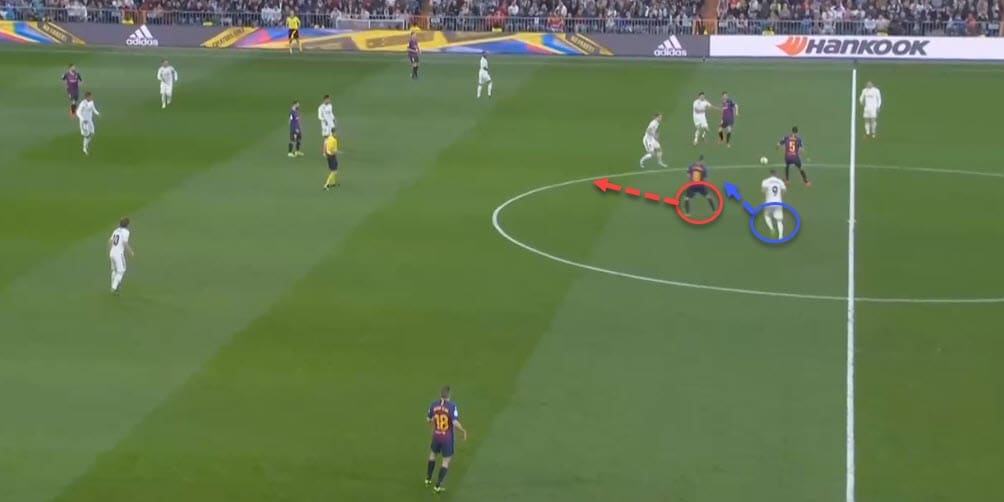
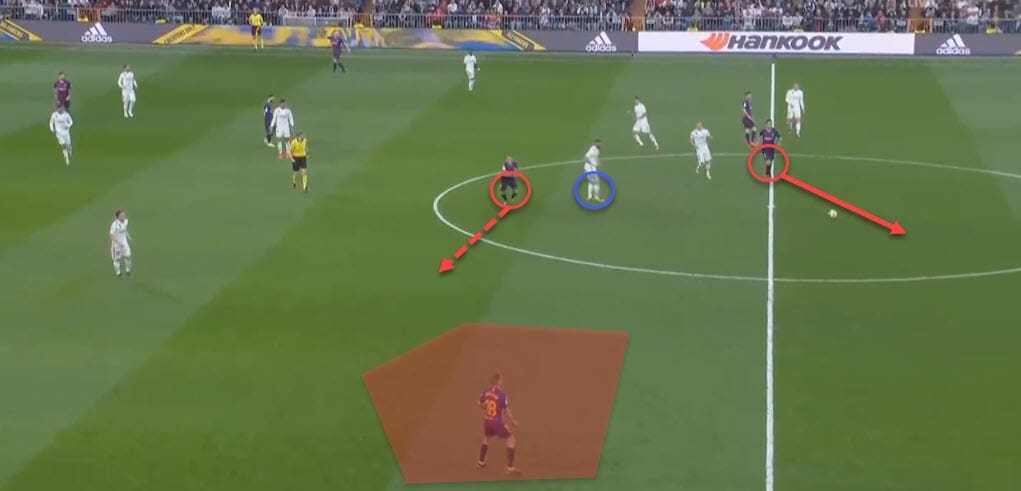
After a long while, Barcelona finally had more than just one outlet and were acting more as a team rather than focusing on individual brilliance. Real Madrid maybe didn’t expect such a drastic change so they stuck to their usual tactics.
Lionel Messi was not as impressive, nor did he not stand out as much as we’re used to seeing, and that goes for all three recent Clasicos. This could partly be due to his fitness but Los Blancos did put considerable effort into stopping him.
Not only did the Argentine always effectively have a dance partner on his back, but the team in white made sure he was always surrounded by multiple markers, as can be seen below.
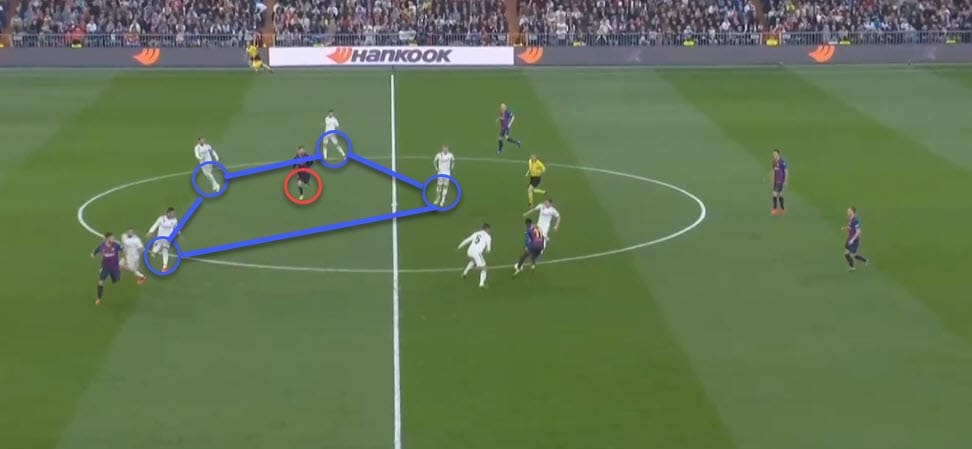
This target on his back meant that Messi would still have to drop back and find safety in numbers to always have a way out. Dribbling was not really an option most of the time, as the little wizard got knocked over more often than not. But by simply playing in line or in-between the midfield trio, Messi was safer and could send passes left and right.
And this is literally what happened on the pitch. Finally, Barcelona could fire on both wings, albeit not to the same extent. Just having a passing option on both sides meant the world of difference to the Catalans and also made their jobs a lot easier.
Real Madrid, on the other hand, had a problem Barcelona faced in the match prior to this: their right wing was deserted. Not literally, because Gareth Bale was the wide winger there, but the Welshman had the fewest touches in the game as a whole, only managing 21 with the next in line being Karim Benzema with 39.
Even the goalkeepers had a similar number with Thibaut Courtois’ tally being up to 37 and Marc-Andre ter Stegen’s 35. Understandably, that was a huge concern, as the attacking sides bellows do show.

With Real Madrid only focusing on the left side of the pitch, all Barcelona had to do was apply a plaster there and most of their problems would be solved. That came in the form of Rakitić or Busquets, and once the Reguilon-Vinicius tandem was tamed the Catalans had already weathered the storm.
Gareth Bale left the pitch to thunderous whistles from his own fans as his time in the famous white shirt might slowly be coming to an end.
Conclusion
It was quite a historic night between Barcelona and Real Madrid at the Santiago Bernabeu. Los Blancos’ dominance is waning as time passes by and the alarms might be sounding off pretty loudly and pretty soon. The proof of how the tides have been shifting in the last decade lies in the stat that Barcelona had amassed a total of 13 wins in Madrid until 2003, but since they have racked up the same amount.
But the crazy stats do not really stop there. This was also Real’s third consecutive home defeat for the first time since 2004 and Barcelona’s fourth win at the Bernabeu in a row, not to mention that they have not failed to score in a Clasico for 23 straight games.
And now it’s been five years since Real Madrid last beat Barcelona in the Spanish Capital. This might be proof of the Catalans’ dominance, but also proof of one little Argentine wizard’s legacy with the Red and Blues. El Clasico’s win record before Lionel Messi read Barcelona 66-87 Real Madrid. Now, during Messi’s era, it stands at Barcelona 96-95 Real Madrid. Coincidence? We’ll leave you to decide.
Be that as it may, it will be rather interesting to see how Real continue their campaign with these big blows to their season. Now that La Liga and the Copa del Rey are practically both out of reach, their only shot at silverware is the Champions League. The Royal Whites have been dominating Europe’s most coveted tournament ever since its inception, so betting against them, even in times like these, is unwise.
Barcelona, on the other hand, are in the final of the Copa, have a rather firm hold of La Liga’s top spot but are still on shaky ground with the Champions League. The crucial period of the season is slowly approaching, and ‘Hlebruary’ is finally over. Ernesto Valverde had better have some more tricks left up his sleeve because the race for silverware is far from over.
If you love tactical analysis, then you’ll love the digital magazines from totalfootballanalysis.com – a guaranteed 100+ pages of pure tactical analysis covering topics from the Premier League, Serie A, La Liga, Bundesliga and many, many more. Buy your copy of the February issue for just ₤4.99 here, or even better sign up for a ₤50 annual membership (12 monthly issues plus the annual review) right here.

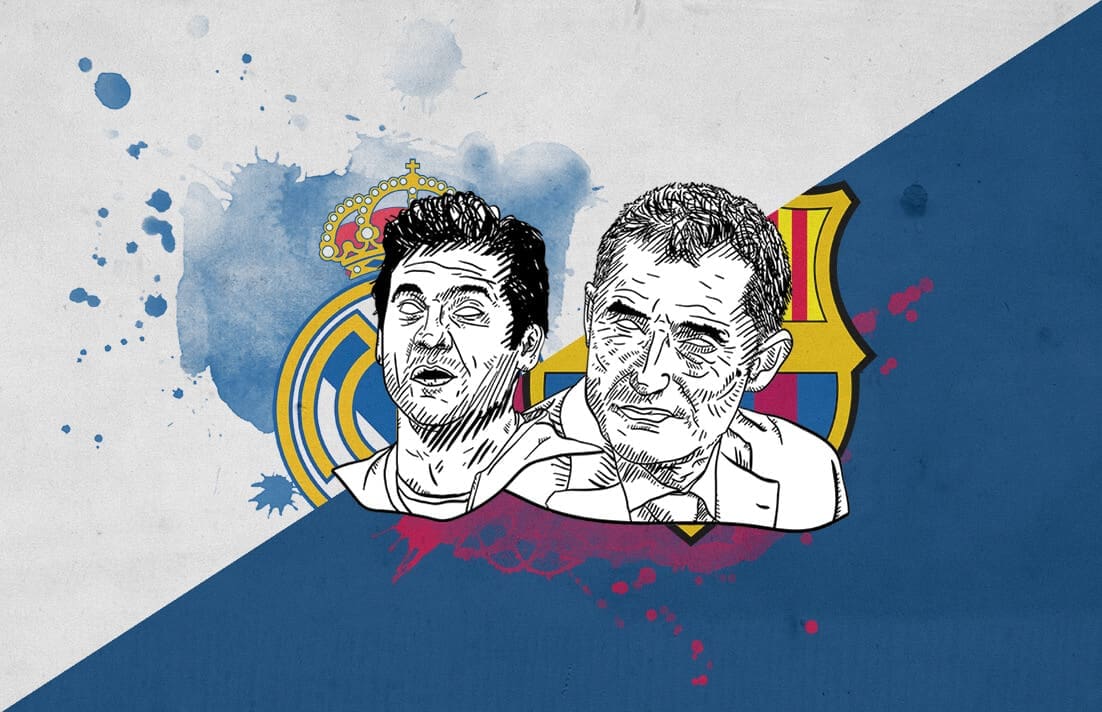




Comments